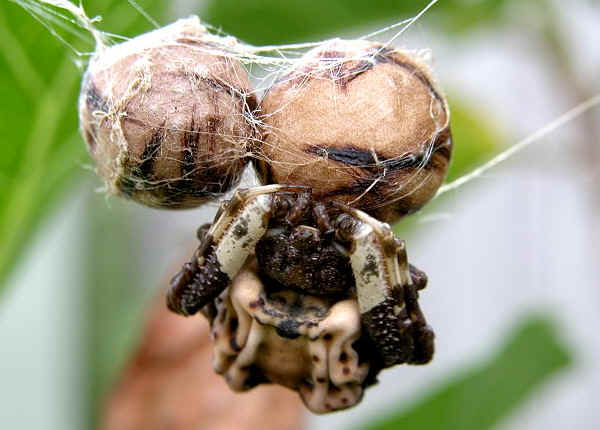Bird-dropping Spider - the Mimic Master
Celaenia excavata (C. kinbergii ) FAMILY ARANEIDAE
This page contains pictures and information about Bird-dropping Spiders that we found in the Brisbane area, Queensland, Australia.

- Female, body length 15mm, with two egg sacs.
- We call the Bird-dropping Spiders as the Mimic Master because they use two different mimic methods to survive, one to avoid predator and the other to capture prey.
Bird Dropping Mimic
- You may think this is a bird-dropping, actually it is a spider. It sits motionlessly on the leaf on day time and active at night. The spider has evolved an effective strategy against being eaten by day-active predators such as birds and wasps. Its body mimics unappetising bird droppings. They are dirty white, grey and black in colour, with very large abdomen. Bird-dropping Spiders are sometimes called Bird Dung Spiders. They are also known as Orchard Spiders because they are so commonly seen in citrus and other orchards. They are quite common in Brisbane suburban gardens but often overlooked.


- Bird-dropping Spider is quite a large spider. Its size, colour pattern and resting posture all make it look like a dung. The abdomen of the spider is broad and triangular in shape, concave along midline, and has a pair of roughened humps near the rear. Its legs are usually held folded against body when it is at rest.


- The spider belong to family ARANEIDAE although only the young spiders make web. The female adults attack their prey directly. The female is quite a large spider, grow up to body-length 20mm. The male spiders are tiny, body-length 3mm. We often find the female, but seldom see the male or the young with web.


- Bird-dropping Spiders are also know as Death's Head Spider because if you look at them from the top, they look like a skull.
- The young Bird-dropping Spiders make web, however, the female adults attack their prey directly. At night the spiders hang upside down from leaf or twig and wait for the moths, with their long spiny forelegs open and ready to seize.


- We found that the adult spiders only capture one species of moth. The spider drops the empty prey shell onto the ground after feeding. We put a large disk on ground under the spider, we collected over 20 preys of two Bird-dropping Spiders and confirm all are one species of moth, the Spodoptera mauritia, Lawn Armyworm.
- Scientists found out that the spiders give off a scent which attracts a particular species of male moths. The spiders release pheromones that mimic the sex scent of Lawn Armyworm female moth (known as "aggressive mimicry"), attracting unwary male moths and attack when the moth come close. The spiders grab the moths with their strong front legs.
- The spiders hang and wait for prey at the same position every night, however, the spiders may face different direction. We found that the spiders usually face the downwind direction, where the moths will come from.
- We noticed that the moths have large compound eyes and believed that they can see in the dark. The waiting posture and colour patterns of the spiders may mimic the female moths as well.


- The spider waits for prey with two pairs of front legs open. It catches and bite the prey then warp it into cone shape.


- We recorded that the spiders can sometimes catch one prey, sometime two each night. More preys on end May to early June. Less in end June.


- The spider either eats the moth straight away or stores it for later, wrapped in silk. The spider drops the empty shell when finish.

- When not finish, the moth may be hung next to the egg-sacs in day time.

- Spodoptera mauritia, Lawn Armyworm, adult body length 20mm
- Prey on by Bird Dropping Spiders. More information about this moth please find in this page.


- From late summer to early winter, female Bird-dropping Spider makes ball shaped egg sacs. The egg sacs are brown in colour with dark line patterns, about 10 mm in diameter, sometimes tied loosely together by webbing. The egg sacs are quite commonly found hanging on plants but not recognized for what they are. Up to 10 sacs are silked together in a group, beneath which the spider may be found sitting by day or hanging by night awaiting prey.


- The female Bird Dropping Spider spends large amount of time on making her egg-sacs. The spider usually hangs her egg sacs under leaves about one meter from ground. She usually start to build egg sac after evening.


- After she finishes two or three preys, her abdomen becomes very large, she starts to make another egg-sac. She lays hundreds of eggs on a silken sheet, then bundles it up into a small ball, about 10mm. She further covers the ball with layers of silk and finally extracted some liquid on the silken ball makes it turns into dark brown colour. Then she hangs the egg-sac together with other egg-sacs she already made.


- The mother spider usually guards her egg sacs until the young spiders emerge. The baby spiders emerge in late winter or early spring and disperse by ballooning.
-


- Reference:
- 1. Wildlife of Greater Brisbane - Queensland Museum 1995, p26.
- 2. Bird-dropping spider - The Find-a-spider Guide for Australian Spiders, University of Southern Queensland, 2007.
- 3. A Guide to Australian Spiders - Densey Clyne, Melbourne, Nelson 1969, p73 .
- 4. Australian Spiders in colour - Ramon Mascord, Reed Books Pty Ltd, 1970, p70.
- 1. Wildlife of Greater Brisbane - Queensland Museum 1995, p26.
